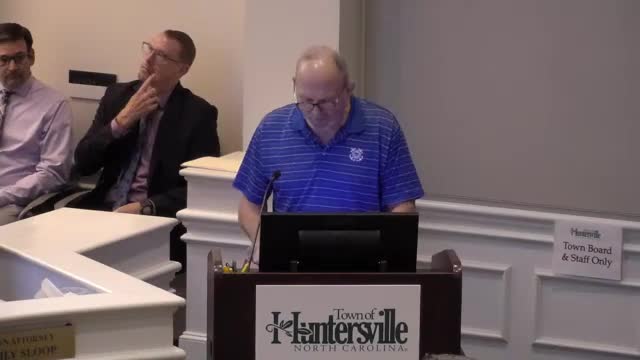Community rallies against controversial development proposal
August 07, 2024 | Huntersville, Mecklenburg County, North Carolina
This article was created by AI summarizing key points discussed. AI makes mistakes, so for full details and context, please refer to the video of the full meeting. Please report any errors so we can fix them. Report an error »

In a recent government meeting, significant concerns were raised regarding a proposed development project that could impact local neighborhoods and the environment. The discussion centered around an application for mixed-use zoning that would allow for the construction of a mini-storage facility and other potential commercial uses on four lots, with particular focus on Lot C, which is currently designated for mini-storage.
Residents expressed strong opposition to the proposal, citing potential negative effects on the community, including loss of natural vistas, increased noise, and unpleasant odors reminiscent of past developments. One speaker highlighted the proximity of the proposed site to hiking trails and residential areas, arguing that removing trees would diminish the area's aesthetic and environmental quality.
Concerns were also raised about the adequacy of the proposed buffer zones between the development and nearby neighborhoods. The applicant requested a reduction from an 80-foot buffer to just 35 feet, which residents argued would not sufficiently mitigate the impact of the development. They referenced zoning ordinances that stipulate buffer requirements and questioned the rationale behind the proposed changes.
Additionally, the traffic impact analysis (TIA) presented by the applicant was criticized for only addressing the mini-storage traffic and failing to consider the broader implications for surrounding areas, including a nearby school. Residents voiced worries about increased commercial vehicle traffic and its potential risks to children attending the school.
The meeting also revealed that the applicant had listed the properties for sale at a significantly higher price than their purchase price, raising questions about their commitment to the project. Community members urged the board to deny the application, arguing that it prioritizes the interests of a single business entity over the well-being of the community.
As the meeting concluded, the board was left to consider the implications of the proposed development, with residents advocating for a more community-oriented approach that aligns with existing zoning regulations and protects local quality of life.
Residents expressed strong opposition to the proposal, citing potential negative effects on the community, including loss of natural vistas, increased noise, and unpleasant odors reminiscent of past developments. One speaker highlighted the proximity of the proposed site to hiking trails and residential areas, arguing that removing trees would diminish the area's aesthetic and environmental quality.
Concerns were also raised about the adequacy of the proposed buffer zones between the development and nearby neighborhoods. The applicant requested a reduction from an 80-foot buffer to just 35 feet, which residents argued would not sufficiently mitigate the impact of the development. They referenced zoning ordinances that stipulate buffer requirements and questioned the rationale behind the proposed changes.
Additionally, the traffic impact analysis (TIA) presented by the applicant was criticized for only addressing the mini-storage traffic and failing to consider the broader implications for surrounding areas, including a nearby school. Residents voiced worries about increased commercial vehicle traffic and its potential risks to children attending the school.
The meeting also revealed that the applicant had listed the properties for sale at a significantly higher price than their purchase price, raising questions about their commitment to the project. Community members urged the board to deny the application, arguing that it prioritizes the interests of a single business entity over the well-being of the community.
As the meeting concluded, the board was left to consider the implications of the proposed development, with residents advocating for a more community-oriented approach that aligns with existing zoning regulations and protects local quality of life.
View full meeting
This article is based on a recent meeting—watch the full video and explore the complete transcript for deeper insights into the discussion.
View full meeting
